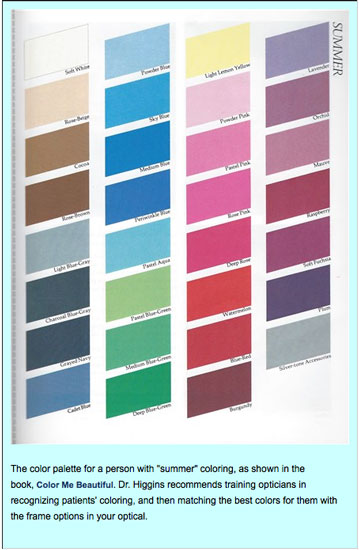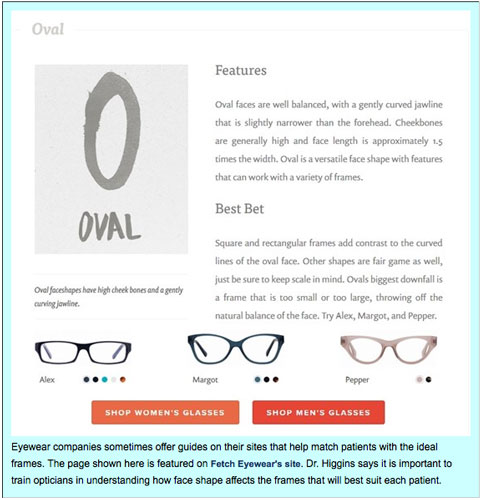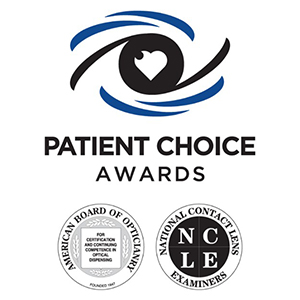This article is reprinted with kind permission from Review of Optometric Business [Joe please add a link and a small logo from ROB so readers can access ROB easily http://www.reviewob.com/elevate-your-opticians-to-style-consultants.aspx
SYNOPSIS
Opticians who transition from technicians to style consultants offer personalized service that maximizes optical sales. See how your staff can upgrade their stylist skills.
ACTION POINTS
UNDERSTAND COLORING & FACE SHAPE. Teach opticians how to match eyewear to the patient's coloring and face shape.
COLLECT STYLE RESOURCES. Googling "coloring and eyewear," or "face shape and coloring," will offer many sites to reference. And books like "Color Me Beautiful" are also good resources.
ROLE-PLAY. Have patients practice styling you and each other. Observe interactions with patients to see if they are able to fulfill the role of style consultant.
PROMOTE YOUR "STYLE CONSULTANTS." Highlight individual "style consultants" with style tips in patient communications.
You have an opportunity to transform your opticians from technical experts at eyewear and fitting glasses to style consultants, capable of helping patients turn their eyewear purchase into the completion of a total look. This not only helps patients leave the practice satisfied and primed to refer others, it also makes it more likely that these patients will make future purchases in your optical.
Having opticians capable of serving as style guides to patients adds a competitive advantage. This cannot be replicated online, and it gives patients yet another reason to visit your practice for their next eyewear purchase.
Style-savvy opticians are cultivated by hiring people with the potential for style consulting, then providing training that builds on that potential. Once you have your "stylists" in place, promote their services to patients, so they know they get more than an optician who just knows the specs on frames and lenses and how to measure them for glasses. I promoted my opticians as image consultants on our web site, on social media, in person to patients and in advertising.
Optometric practice owners have an opportunity in their opticians to do what other industries have done for years. Barbers have become "hair stylists," high-end stores provide "personal shoppers," and vendors of home goods have become "home style consultants."
My former practice, Unique Optique, had a practice that established an individualistic style, selling only independent-brand frames, pre-setting patients to expect style-savvy. We ensured our opticians delivered on that expectation.
 Teach Style-Savvy
Teach Style-Savvy
The most important knowledge for opticians to have is basic optical competence. It is imperative to know how to measure a progressive, what material and lens treatment options are available and what frame shapes are best for which prescriptions.
It is a beneficial bonus if they also have a knack for fashion and style. The image portion of this equation is difficult to find.
Train in Parts of Style that Are Not Subjective
Some components of style are subjective. What is not subjective is image basics, like a person's coloring and the way a frame fits certain facial features.
A potential employee needs to "own" their style. You can tell when a person is comfortable in their own skin and clothing. Even if the person is not innately stylish, the most important part is being able to explain to a patient why one option works while another does not.
For example, the temples of a frame should go straight back to their ears and not splay out and press on their temples. Another example includes that a round frame on a fuller face does not work well. And an orange frame will not work on a person with yellow-toned skin.
Find Starter Style Information Online
You can find basic online training for style in eyewear. If you simply Google "face shape and eyewear" or "coloring and eyewear," there are sites that explain a person's face shape and coloring, and which clothing or frame shapes or colors will complement. You can find color theory classes for your staff to attend, possibly at the local college.
For example, the Clearly Face Shape Guide for Glasses can guide your opticians on finding the right eyewear for each face shape.
Build a Style Library for Opticians
For coloring, the 1980's book, Color Me Beautiful is helpful. It is as valid today as back then. I gave each employee a copy of this resource. We would analyze if a person had cool or warm coloring, as that gave us enough information to go on for a frame color. Cool-colored people would be steered toward blue, purple, green, silver and black. Warm-colored people would be directed toward yellow, orange, red and gold.
I would start with fitting the frame to the patient's head size, and then continue on to style for the shape of their face. I gave a presentation on fitting a frame to local business groups. I also gave this presentation to my employees. To illustrate, I would show them pictures of celebrities who were warm or cool-colored. I would do the frame fitting myself at first, so the employee could watch and get a feel for the process.
Build on Patient's Existing Style
Every patient is different. Some know exactly what works, or doesn't work, for their coloring and face shape. Most were completely clueless. We saw a trend over the years where initially the patient would come in controlling the situation to exactly what they thought they wanted. Over time, as they trusted us more, they would allow us more and more input and their style got more and more adventurous. We grew our reputation for being the experts in finding that out-of-the-box frame that still complemented who you were. Our image consultant opticians learned over time when to tread lightly and when to run.
The best way to help the patient is to observe them and help determine their style. We want to use their style (conservative, wild, punk, trendy, etc) and then find what fits their ideas, even if it does not match our idea of style.
For example, a conservative, pearl-wearing lawyer would not be fit with a purple cat eye. If their preferences are in question, ask them: "What colors do you wear?" (Remember that they are most likely not wearing their optimal colors.) "What would you say your style is? Conservative, trendy? What is your job? Hobbies?"
For help matching the patient with the best eyewear for their coloring, we used brown and black drapes to place around the patient to help block whatever they were wearing. We also used an in-office photo booth to get another take on whether the frame shape worked with the patient's face.

Role Play Being a Style Consultant
For practice, I would have opticians style each other and me. I would have them watch my interactions with patients. And then they would style patients with my supervision. The style consultant role would usually become refined with time and experience.
Listening to your employee’s patient interactions is always a good idea. I was lucky in that we had an open floor plan and I could hear every word that was spoken. I was able to give much feedback and monitor the progress of new staff, much to their chagrin.
Ask Staff to Keep You Updated on Patient Style Needs
My staff would tell me what patients were asking for, especially if there was a trend that we were not fulfilling. As the opticians got savvier, I would give them the power of ordering frames when the reps came in.
For example, a number of patients asked if we carried Lafont, which at the time we did not. We brought it in soon after. We also had requests for wood frames, for which I never found company to buy from that I liked. So, sometimes we complied, and, sometimes, we chose not to.
Use your staff to expand your services to your patients. Your patients will thank you.
 Maria Higgins, OD, owns The Unique Technique, a business and marketing consultancy. She formerly owned The Unique Optique in Frederick, Md. To contact her: [email protected].
Maria Higgins, OD, owns The Unique Technique, a business and marketing consultancy. She formerly owned The Unique Optique in Frederick, Md. To contact her: [email protected].













